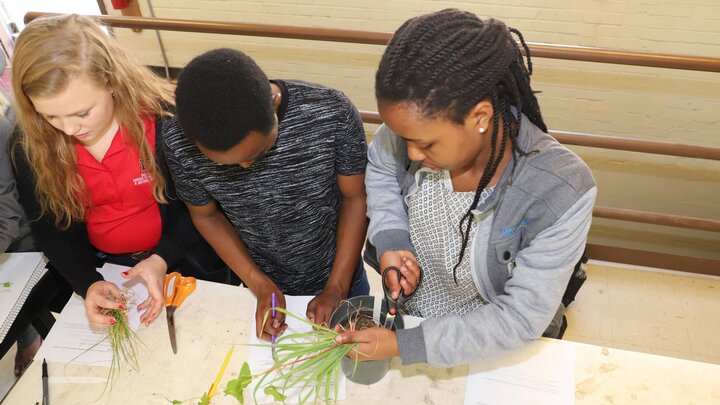Students in Agronomy 204 Resource Efficient Crop Management class cut cover crops prior to weighing.
College of Agricultural Sciences and Natural Resources students in Andrea Basche's spring semester Agronomy 204 Resource Efficient Crop Management class made real-world decisions by planning, planting, cutting and weighing plants in a cover crop challenge.
Basche, a University of Nebraska–Lincoln assistant professor of agronomy and horticulture, said the challenge gave her students practical experience growing and evaluating cover crops.
“The goal was to grow the most cover crop biomass and the most diverse cover crop mix for the least cost,” Basche said, “and to prepare students to solve complex problems where multiple priorities and considerations needed to be evaluated.”
Cover crops, as defined by Sustainable Agriculture Research and Education, are plants used primarily to slow erosion, improve soil health, enhance water availability, smother weeds, help control pests and diseases, and increase biodiversity and crop yields.
Diverse mixes used by the students included buckwheat, radish, crimson clover and several grass species including oats, cereal rye and barely.
Under a changing agricultural landscape, today’s producers are under competing demands to not only sustain their livelihoods, but to maintain finite soil and water resources for the future, while producing for a shifting consumer marketplace. Cover crops are increasingly being studied and used to improve overall productivity and to address sustainability concerns such as soil degradation, water pollution and herbicide-resistant weeds.
According to the United States Department of Agriculture Census of Agriculture, cover crops are only used on approximately 4% of Nebraska cropland. Producers cite many barriers that include lack of time between fall harvest and spring planting for sufficient growth to make their investment worthwhile.
“Through the cover crop challenge, students were introduced to a number of different cover crop plant species and gained firsthand experience with how much growth is possible,” Basche said, adding student work determined seed cost, how various mixtures fared and how biomass was produced.
To prepare for the challenge, students measured four different species growing in the greenhouse at five different seeding rates ranging from less than recommended, recommended and higher than recommended rates. Students gained practical management experience by determining planting rates, species characteristics and performance, and costs associated with different seeds.
The 103 students then worked in groups of three to four to plan and plant two cover crop experiments – one grown in the teaching greenhouse and another in a field, both on East Campus. Over a five-week period, students watered the plants in the greenhouse while the field plants were rain-fed.
Groups could choose any species or combination from 13 different cover crop options.
Next, they calculated seed weight and seed cost per acre, just as a producer would do to determine an appropriate seeding rate.
Real-life farming conditions in the field delayed planting by almost two weeks due to the wet weather. Harvest had to be done after only 3.5 weeks to finish the project by semester’s end.
Winning teams and their cover crop species combinations were:
- Didier Ndenga, integrated science junior, Trey Kedoliczak, 2019 CASNR graduate and Mark Freyhof, agriculture engineering senior. Their cover crop mixture contained cereal rye, oats, ryegrass and buckwheat.
- Regan Kerkman, meteorology-climatology senior, Terence Irumva, integrated science major junior and Jean d'Amour NDATIRA, integrated science senior. Their cover crop mixture contained seed buckwheat, cereal rye and radish.
- Reid Pretzer, agronomy junior, Robert Cyuzuzo, integrated science junior and Clement Niyirora, integrated science senior. Their cover crop mixture contained buckwheat and spring oats.
- Ryan Dorn, mechanized systems management senior, Patience Gihozo, integrated science major junior and Christian Nduwumwami, integrated science sophomore. Their cover crop mixture contained cereal rye and crimson clover.
- Eugene Baraka, integrated science junior, Gloria Dukuzeyesu, integrated science junior and Kurt Nelson, agricultural economics senior. Their cover crop mixture contained buckwheat and spring oats.
Didier Ndenga, left, Trey Kedoliczak, and Mark Freyhof.
Regan Kerkman, left, Terence Irumva and Jean d'Amour Ndatira.
Reid Pretzer, left, Robert Cyuzuzo, and Clement Niyirora.
Ryan Dorn, left, Patience Gihozo and Christian Nduwumwami.
Eugene Baraka, left, Gloria Dukuzeyesu and Kurt Nelson.




